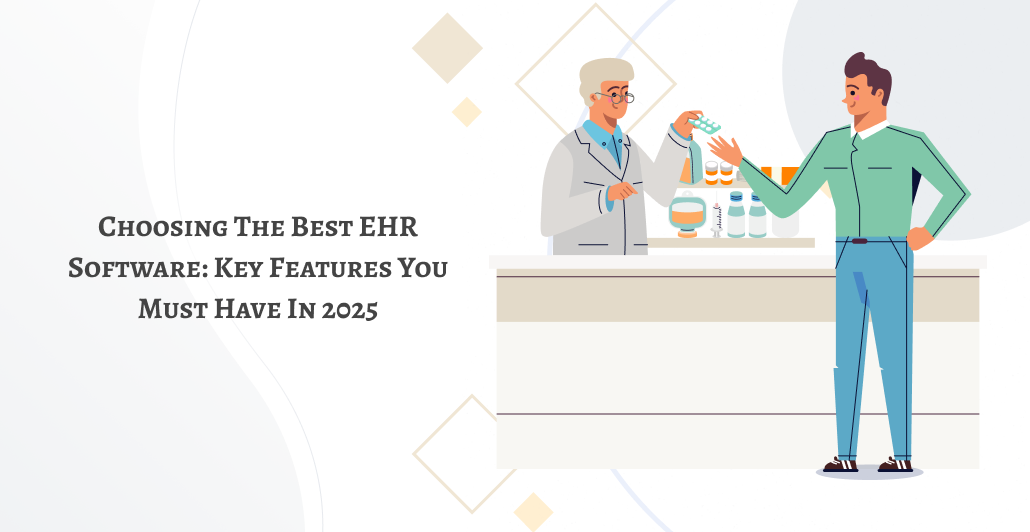Introduction
Due to the ever-changing healthcare environment, the choice of the appropriate EHR software is more important than ever. Electronic Health Record (EHR) software has revolutionized the process workflow of healthcare centers to deliver effective patient care, enhanced productivity, and simple information handling. Stepping into 2025, the demand for world-class, AI-based EHR Software solutions continues uninterrupted with increased interest, in particular, in India and other regions across the globe. So, what is this EHR software, and how is it precious to modern-day health professionals?
This comprehensive guide will talk about the future, role, and benefits of EHR software and key features you need to find while choosing the best EHR software for your practice.
What is EHR Software?
Electronic Health Record system software or EHR software is a computer program used to organize patient medical records, automate administrative procedures, and improve clinical processes. In contrast to those constructed of paper, EHR software stores the patient’s data in a digital format, enabling rapid recovery, secure exchange, and better coordination of care among providers.
Emergence of AI-Powered EMR Software has transformed the care of patients through real-time information, better decisions, and error minimization. EHR software India integration in India picked up pace appreciably with healthcare professionals pursuing the modernization of their practice and patient optimization.
The Role of EHR Software in Modern Healthcare
1. Patient Care Improvement
Traditional EHR systems are just a small part of improving healthcare quality. The usage of this software can supply the healthcare providers with more errorless and contemporary data, thus helping them to render the most suitable intervention exactly on time and decreasing the probability of the medical errors.
2. Streamlining Workflow and Efficiency
The EHR system incorporates many features. It is a tool for automatic performance of administrative tasks such as appointment scheduling, creating bills, and documentation. Clinic staff deal less with administrative things and they can concentrate on the patients’ health improvement.
3. Enhancing Data Security and Compliance
Health system security is a major concern in the industry of health care. EHR software is the best security solution because it has powerful encryption and access controls, which defend the information of the patients. It allows a company to be a compliant organization with rules and laws like HIPAA. It makes a company trustworthy since it guarantees patient confidentiality.
4. Facilitating Interoperability
The digitalization of healthcare records empowers the practitioners to share the data of the patient easily with other medical institutions. It is the very first step in the digitization of patient information. This digital sharing of information across the entire healthcare organization helps to cut down on duplication and errors in the health care data.
Key Features to Look for in EHR Software in 2025
1. AI-Powered Capabilities
2025 would be the year when AI-powered EMR Software in the field of healthcare is destined to rule the world. Artificial intelligence in these platforms helps the computer to read, analyze, and understand patient data, as well as to predict and solve health problems and ultimately, come up with better decisions. Thus, a doctor should use EHR software with AI-based analytics and machine learning algorithms that will help him diagnose the problem with his patient and choose the best treatment plan.
2. User-Friendly Interface
The ease of handling is one of the essential prerequisites to ensure that doctors are not confused using this software. Take the EHR with a simple and sleek design, the one that can be customized (with dashboards) and which is easy (with simple navigation) to train the staff quickly and to increase efficiency.
3. Mobile Accessibility
Mobile-friendly EHR software has always been a preferred one since the advent of mobile devices into the healthcare industry. By using the portability of hand-held devices, physicians and nurses can update or modify patient records, review treatment plans, and communicate with their staff from wherever they are in the hospital respectively.
4. Telemedicine Integration
Telemedicine has brought a revolution in the healthcare delivery system. EHR software is the most likely solution to that as it smoothly tightens the end of the telemedicine platform with the electronic health records software for the purpose of virtual consultation, remote patient monitoring, and electronic prescription.
5. Advanced Data Analytics
The evolution of EHR software development can hardly be spoken of without the gypsum of data analytics. Through efficient reporting tools the doctors can notice a patient’s progress, keep track of the performance metrics, and quickly take the necessary measures.
6. Customization and Scalability
Each hospital might demand something different. It is best to have electronic health record (EHR) software that provides customization features and is capable of increasing its capacity to cater to your practice’s growth. The latter action will ensure that the system remains up-to-date and flexible in the face of change.
7. Interoperability and Integration
It is important to know that the EHR software connects with the previously implemented systems, e.g. laboratory management, pharmacy, and radiology. Interoperability is the main factor in the creation of a health care sector that is well-coordinated and functions as a single unit.
The Future of EHR Software
1. AI and Machine Learning
The potential of EHR technology is mainly based on AI and machine learning. EMR software using the power of artificial intelligence will continue to refine diagnoses, reduce or even remove the most administrative tasks, and even better personalize the care of patients. Through predictive analytics, health care professionals now get the ability to predict the need for a patient and counteract health issues before they happen.
2. Blockchain Technology
Blockchain is a chance to break this vicious circle and to build a security model that stores, verifies and protects your EHR data. It is a distributed, immutable record that ensures data integrity and confidentiality, thereby, reducing the risk of hacking it.
3. Cloud-Based Solutions
One of the trends of modern IT is a solution called cloud-based EHR software, which is gaining more and more popularity because of its scalability, cost-effectiveness, and easy remote access. The very presence of cloud EHR solutions means there is no server in your site and at the same time they ensure savings on infrastructure cost and even faster access to real-time data.
4. Enhanced Patient Engagement
A future EHR system should motivate the patients to engage, either via patient portals, mobile applications, or real-time communications. The patients will be allowed to control and manage their entire health data more effectively which will, in turn, make their self-care and following of the treatment plan better.
Benefits of Implementing EHR Software
1. Improved Patient Outcomes
The utilization of EHR software in healthcare boosts the evidence-based clinical decision-making process by providing valuable patient information accurately and exhaustively. This leads to efficient patient care as well, reduced medical errors, and favorable treatment outcomes.
2. Increased Efficiency
Electronic health record system software improves routine administrative work by making it less time-consuming, tedious, and ineffective. This results in faster patient admissions, more patient waiting, and increased resource utilization.
3. Cost Savings
Despite the fact that the initial investment in EHR software is huge, it will be the reason for the long-term cost savings. The reduced paperwork, fewer errors, and improved efficiency are the reasons why the operational cost is lowered.
4. Enhanced Collaboration
Quality electronic medical records software promotes the ease of collaboration among healthcare professionals by allowing real-time data sharing functionality. It means to say that each and every party is well-informed, which is a secret to well-coordinated care, and high-level patient satisfaction.
5. Regulatory Compliance
EHR software is designed to assist organizations in meeting the legal and regulatory requirements, which in turn, minimize the risk of penalties and legal issues. It not only assists in preparing precise documentation for the audit but is also crucial for insurance claims.
Conclusion
Choosing the top EHR software in 2025 calls for thorough research into features, technological innovation, and the individual requirements of your practice. With AI-driven functions, mobile availability, and security for data, the appropriate EHR software has the potential to transform your healthcare provision. Whatever your search may be for EHR software India or international options, an investment in the top EHR software will provide enhanced patient care, increased efficiency, and long-term success.
Enter the future of medicine with state-of-the-art EHR software and set your practice up for excellence and growth in 2025 and beyond.









